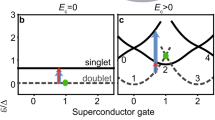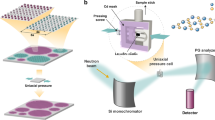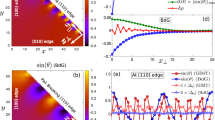Abstract
The Bardeen–Cooper–Schrieffer theory describes the formation of electron pairs, or Cooper pairs, and their instant condensation into a superconducting state. Helium atoms are ‘preformed’ bosons and, in addition to their superfluid state, can also form a quantum solid that lacks phase coherence. Here I show that the fate of Cooper pairs can be more varied than the Bardeen–Cooper–Schrieffer or helium paradigms. In copper oxide d-wave superconductors, Cooper pairs are non-local objects, with both centre-of-mass and relative motions. As the level of doping of charge carriers decreases, the centre-of-mass fluctuations force a correlated d-wave superconductor into a state with enhanced diamagnetism and robust but short-ranged superconducting order. At extreme underdoping, the relative fluctuations take over and two pseudogaps—‘small’ (charge) and ‘large’ (spin)—emerge naturally, as Cooper pairs ‘disintegrate’ and charge detaches from spin-singlet bonds. The ensuing ground state(s) are governed by antiferromagnetic rather than by superconducting correlations.
This is a preview of subscription content, access via your institution
Access options
Subscribe to this journal
Receive 12 print issues and online access
$209.00 per year
only $17.42 per issue
Buy this article
- Purchase on Springer Link
- Instant access to full article PDF
Prices may be subject to local taxes which are calculated during checkout



Similar content being viewed by others
References
Fischer, Ø. et al. Scanning tunnelling spectroscopy of high-temperature superconductors. Rev. Mod. Phys. 79, 353–419 (2007).
Kivelson, S. A. et al. How to detect fluctuating stripes in the high-temperature superconductors. Rev. Mod. Phys. 75, 1201–1241 (2003).
Lee, P. A., Nagaosa, N. & Wen, X.-G. Doping a Mott insulator: Physics of high-temperature superconductivity. Rev. Mod. Phys. 78, 17–85 (2006).
Zaanen, J. Stripes defeat the Fermi liquid. Nature 404, 714–715 (2000).
Chakravarty, S. et al. Hidden order in the cuprates. Phys. Rev. B 63, 094503 (2001).
Li, L. et al. Low-temperature vortex liquid in La2−xSrxCuO4 . Nature Phys. 3, 311–314 (2007).
Melikyan, A. & Tešanović, Z. A model of phase fluctuations in a lattice d-wave superconductor: Application to the Cooper pair CDW in underdoped cuprates. Phys. Rev. B 71, 214511 (2005).
Valla, T. et al. The ground state of the pseudogap in cuprate superconductors. Science 314, 1914–1916 (2006).
Tanaka, K. et al. Distinct Fermi-momentum-dependent energy gaps in deeply underdoped Bi2212. Science 314, 1910–1913 (2006).
Yu, L. et al. Spectroscopic distinction between the normal state pseudogap and the superconducting gap of cuprate high Tc superconductors. Preprint at <http://arxiv.org/abs/cond-mat/0705.0111> (2007).
Boyer, M. C. et al. Imaging the two gaps of the high-Tc superconductor Pb–Bi2Sr2CuO6+x . Nature Phys. 3, 807–812 (2007).
Fisher, M. P. A. & Lee, D. H. Correspondence between two-dimensional bosons and a bulk superconductor in a magnetic field. Phys. Rev. B 39, 2756–2759 (1989).
Pereg-Barnea, T. & Franz, M. Duality and the vibrational modes of a Cooper-pair Wigner crystal. Phys. Rev. B 74, 014518–014531 (2006).
Negele, J. W. & Orland, H. Quantum Many-Particle Systems (Addison-Wesley, New York, 1988).
Kotliar, G. & Liu, J. Superexchange mechanism and d-wave superconductivity. Phys. Rev. B 38, 5142–5145 (1988).
Haule, K. & Kotliar, G. Strongly correlated superconductivity: A plaquette dynamical mean-field theory study. Phys. Rev. B 76, 104509–104545 (2007).
Tešanović, Z. Extreme type-II superconductors in a magnetic field: A theory of critical fluctuations. Phys. Rev. B 59, 6449–6474 (1999).
Nguyen, A. K. & Sudbø, A. A new broken U(1)-symmetry in extreme type-II superconductors. Europhys. Lett. 46, 780–786 (1999).
Herbut, I. F. A Modern Approach to Critical Phenomena (Cambridge Univ. Press, Cambridge, 2007).
Appelquist, T. W., Bowick, M., Karabali, D. & Wijewardhana, L. C. R. Spontaneous chiral-symmetry breaking in 3-dimensional QED. Phys. Rev. D 33, 3704–3713 (1986).
Shenker, S. H. & Fradkin, E. Phase diagrams of lattice gauge theories with Higgs fields. Phys. Rev. D 19, 3682–3697 (1979).
Bartosch, L., Balents, L. & Sachdev, S. Detecting the quantum zero-point motion of vortices in the cuprate superconductors. Ann. Phys. 321, 1528–1546 (2006).
Acknowledgements
I thank N. P. Ong, L. Li, M. Franz, A. Melikyan, S. Sachdev, A. Sudbø and O. Vafek for discussions. This work was supported in part by NSF grant DMR-0531159.
Author information
Authors and Affiliations
Corresponding author
Rights and permissions
About this article
Cite this article
Tešanović, Z. d-wave duality and its reflections in high-temperature superconductors. Nature Phys 4, 408–414 (2008). https://doi.org/10.1038/nphys910
Received:
Accepted:
Published:
Issue Date:
DOI: https://doi.org/10.1038/nphys910
This article is cited by
-
New Results on the Anomalous Precursor Diamagnetism in the Underdoped La1.9Sr0.1CuO4 Superconductor
Journal of Superconductivity and Novel Magnetism (2013)
-
Superconductor–insulator transition in La2 − xSr x CuO4 at the pair quantum resistance
Nature (2011)
-
The mystery and the mystique
Nature Physics (2011)
-
Vortex Excitations Above T c in the Cuprate Superconductor Bi2Sr2Ca2Cu3O10 as Revealed by ESR
Applied Magnetic Resonance (2011)
-
Mott physics, sign structure, ground state wavefunction, and high-T c superconductivity
Frontiers of Physics (2011)



